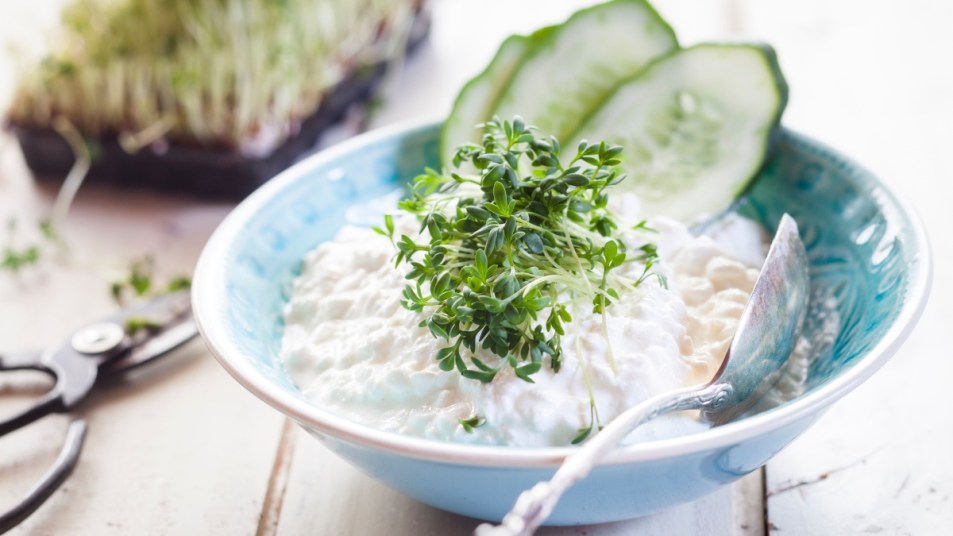This Delicious Low-Calorie, High-Protein Snack Boosts Digestive Health and Promotes Fat Loss

When I’m short on time in the mornings, my go-to breakfast is a bowl of yogurt. I’ll add banana, berries, and maybe a sprinkle of granola if I’m trying to make things interesting. However, I recently began wondering if I could spruce up my first meal of the day with a different base — that is, something other than yogurt. That’s when I re-discovered cottage cheese and found out that it’s much more than just a yummy swap.
My go-to brand at the moment is Good Culture (Buy from Target, $4.99, prices vary at local grocery stores). It ticks all my boxes: It’s rich, creamy, filling, high protein, made with organic ingredients, and includes live active cultures. The last part was surprising to me — I never knew that some types of cottage cheese are probiotics. Excited by the potential benefits for digestive health, I reached out to Michelle Rauch, MS, RDN for the Actors Fund Home in Englewood, New Jersey.
Is all cottage cheese probiotic?
Not every cottage cheese brand was created equal. As explained by Rauch, active cultures must be added to this dairy food in order for it to be considered a probiotic. And that’s a good thing. “While cottage cheese already has a positive reputation as a healthy option, but when probiotics are added, it can be considered a superfood,” she says. “The package should mention ‘live and active cultures’ or have typical strains such as lactobacillus (L. acidophilus), Bifidobacterium bifidum (or B. bifidum), or Lactobacillus casei (or L. casei) included in the ingredients list.”
In addition, Rauch assures us that the bacteria in cottage cheese are good. “The word ‘bacteria’ may have a negative connotation. However, it is important to know that there are bacteria that are good or ‘helpful,’” she says. “The goal is to have the proper balance! Probiotics in our diet, whether it be via cultured or fermented foods or in supplement form, are beneficial to keep our gut in check.”
Without a good balance, Rauch says that you may experience indigestion, inflammation, and infections. An imbalance of gut flora is also linked to irritable bowel syndrome (IBS), bloating, diarrhea, and constipation. On the other hand, a good balance of gut bacteria (aided by probiotics) may help alleviate ulcers and allergies and protect against colon cancer. “While so much has been studied about probiotics, there is still much to learn,” she adds.
What are the other nutritional benefits of cottage cheese?
“Cottage cheese is rich in protein which is why it has had the reputation of a ‘diet’ food,” says Rauch. “Just a half cup has 14 grams of protein and fewer than 100 calories. Its high protein content will help keep those hunger pangs at bay. And casein [a key protein in cottage cheese] is slowly digested, which helps with satiety. Cottage cheese can be considered a ‘complete protein’ as it contains all essential amino acids.”
Indeed, a 2011 study from The Journal of Nutrition found that eating more high-protein dairy products can help women lose more fat and gain more lean muscle. And a 2018 study published in The British Journal of Nutrition found that consuming 30 grams of protein (in the form of cottage cheese) before bed may have a positive effect on metabolism and overall health.
Also, Rauch points out that cottage cheese is an excellent source of calcium. “Calcium plays a major role in the prevention of osteoporosis and the regulation of blood pressure,” she says. “And it may play the role in preventing some types of cancer. Just four ounces has as much as 130 milligrams (mg) of calcium, or 10 percent of the Recommended Daily Allowance (RDA).”
Another important nutrient in this dairy product? Phosphorus. “Cottage cheese is an excellent source of phosphorus, providing between 25 to 30 percent of your RDA,” says Rauch. “Together with calcium, phosphorus is a key element in bones and teeth. Phosphorus is also essential as a component of DNA, RNA, and cell membrane structure.”
Other essential nutrients in cottage cheese include selenium, B vitamins, and potassium. “A half cup has 10 micrograms (mcg) or 15 percent of the RDA of selenium,” Rauch says. “Selenium is essential for thyroid function [and plays] vital roles in reproduction, DNA synthesis, and protection from oxidative damage. The same portion also contains about 3 percent of most B vitamins and potassium and 5 percent of the RDA of vitamin A.”
What’s the best way to eat cottage cheese?
Tired of eating plain cottage cheese with a side of fruit? Rauch has the best ideas to help elevate your meals. The trick is to think of it as an add-in for savory foods, not just sweet ones. Here are her favorite savory recipes:
- Cottage bowl. “First, I place about 3/4 of a cup of 1 percent Cottage Cheese into a bowl,” says Rauch. “I add in sliced Persian cucumbers, yellow bell peppers, halved grape tomatoes, chives, olives, unsalted toasted nuts, such as almonds or pistachios (chopped or slivered) and a little black pepper. Feel free to mix up the veggies and nuts for some variety. Avocado is a nice touch as well!”
- Creamy scrambled eggs. “Add a tablespoon of cottage cheese into scrambled egg bites or a quiche for added protein and creaminess,” she suggests. To make it, pour scrambled eggs into a greased muffin tin with veggies like spinach, tomatoes, peppers, and onions. Then, scoop about a tablespoon of cottage cheese into each muffin tin. Bake at 400 degrees Fahrenheit for about 40 minutes.
- Indulgent baked potatoes. “Top a baked potato with cottage cheese and chives in lieu of sour cream!” Rauch says.
I can’t wait to try Rauch’s ideas — especially those scrambled egg bites!
This story was not sponsored by Good Culture. Good Culture provided product samples at no cost to our editor.












